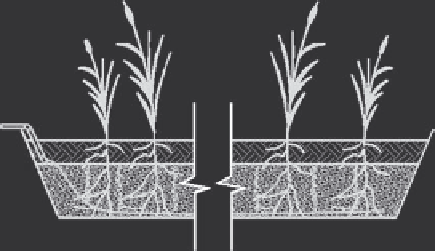Environmental Engineering Reference
In-Depth Information
Aggregate
Mulch
Cleanout
Q
in
Q
out
FIGURE 19.9
Subsurface-flow wetland schematic. The mulch layer is used in cold climates
to prevent freezing in winter. In warm climates, a thin layer of mulch prevents odors from
escaping the wetland bed.
transport wastewater. Control of nutrients or cultural values also can create demand
for advanced treatment.
Ecotechnology is not restricted to passive systems. Supplemental mechanical
power inputs to semipassive systems are a common feature of ecotechnology to
achieve higher levels of treatment performance (Austin, Lohan, and Verson 2003;
Wallace 2001b; Behrends et al. 2000) or to reduce the area required for treatment
(Table 19.1). These power inputs include aeration and flood and drain pumping.
Aerated wetlands are subsurface-flow systems supplied with air distribution tub-
ing underneath the aggregate and a blower to push air through the tubing into the
wetland bed (Figure 19.10). For domestic sewage, these systems probably best serve
fifty to one thousand individuals to realize economies of scale in construction and
operation. Both smaller and larger systems have been successfully used. The largest
Aeration header
Air header
Liner
Air
Mulch layer
Gravel bed
Air line
Air line connection
FIGURE 19.10
Aerated wetland schematic. System depicted is known as Forced Bed
Aeration™ (Wallace 2001b). The wetland bed alternates between aerobic aerated zones and
anaerobic passive zones.





































Search WWH ::

Custom Search